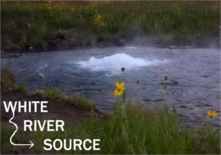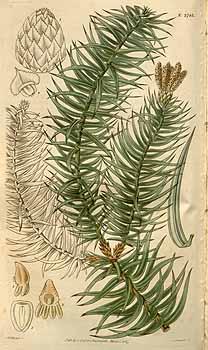
|
|
 |
| Trees &
Shrubs Botanical Index |
Trees
& Shrubs Common Name Index |
Trees &
Shrubs Seed Germination Tips |
Growers Accessories |
| Vegetable
Seed |
Flower
Seed |
Herb Seed |
Home |
 #A1855 Cunninghamia lanceolata |
|
China Fir Cunninghamia lanceolata (syn. Pinus
lanceolata, Cunninghamia sinensis, Cuninghamia unicanaliculata) Considered the most primitave of the cypresses, a member of the family Cupressaceae (formerly Pinaceae) and native to China, Taiwan, Vietnam and Japan. Trees are 30-70 feet in height (though it can be much taller in its native areas) and pyramidal in shape with long (3 inch) soft dark green or blue green leaves and somewhat pendulous branches. Leaves spiral about the branches and the tree is likely to sucker when damaged at the trunk, producing a multi-trunked clump. Cones are small and appear in groups of 3 to 5. The trunks are attractive with reddish brown bark which often exfoliates and peels from the trunk in older trees. Dead leaves and twigs remain attached to the tree, sometimes giving it a rather shaggy appearance. Cunninghamia is a warm weather conifer and prefers a rich acidic soil in partial or dappled shade. Excessively cold temperatures will cause the foliage to bronze and die. Any such damage should be removed from the tree. The tree is easily propagated by means of cuttings or seed. No stratification of seed is required. Seed should be sown in a sandy medium at a depth of 1/2 inch and kept moist until germination. Transplant seedlings to a nursery area when they reach about 2 inches in height at a rate of 50 seedlings per 2sq feet and allow them to grow on here for a year. The following season they may be transplanted to larger pots or outdoors to their permanent location when all danger of frost has passed. Cuttings may be taken of soft wood in spring and inserted into sand. These should be kept moist and syringed frequently at about 55F until rooted. The cuttings can then be transplanted to pots or an outdoor nursery area, if all danger of frost has passed. Medicinally, oil from the bark of the trees and burnt ash from the trees has been used to treat bruises and wounds. The oil is also used as an antidote to varnish poisoning. There are reports of it having also been used to treat hernia, cholera, as an expectorant and as a vermifuge. Cunninghamia is a prized construction wood as it is resistant to insects and long lasting when cut. It is often used to construct bridges, telephone poles, ships and other long term structures. #A1855 Packet $16.50, Approximately 100 seeds |
|
#A1855A Cunninghamia lanceolata Bulk Seed 1oz |
|
#A1855A Bulk seed 1oz $24.50, Approximately 3900 seeds |
| #A1855 Cunninghamia lanceolata Bulk Seed 4oz |
|
#A1855B Bulk seed 4oz $41.50, Approximately 15750 seeds |
|
#A1855 Cunninghamia lanceolata Bulk Seed 1lb |
|
#A1855C Bulk seed 1lb $60.50, Approximately 63000 seeds |
Seedlings,
Seeds & Accessories
For
Orchardists
<>
Nurserymen
<>
Farmers
<> Foresters
| HOME | | | HELP/FAQ | | | CONTACT US | | | ABOUT US | | | TERMS | | | SITE MAP |